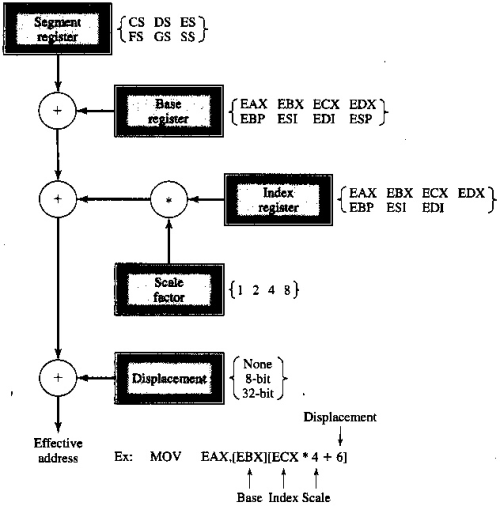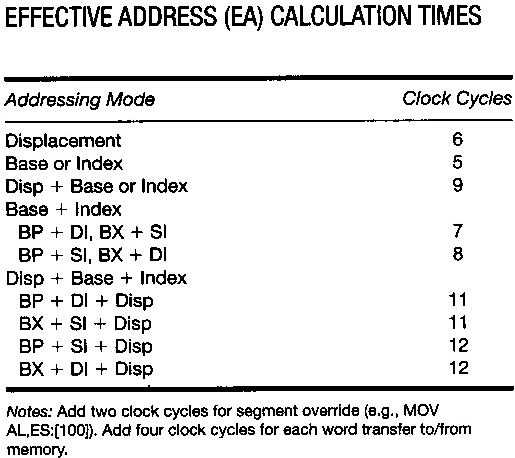-
In indirect memory addressing the base register identifies which segment register will be used to calculate the actual memory location.
-
Therefore, we need to understand the rules that define which register is the base register in indirect memory addressing mode.
-
The default segment register is SS if the base register is EBP or ESP.
-
However, if EBP is scaled, the processor treats it as an index register with a value relative to DS, not SS.
-
All other base registers are relative to DS.
-
If two registers are used, only one can have a scaling factor.
-
The register with the scaling factor is defined as the index register.
-
The other register is defined as the base register.
-
If scaling is not used, the first register is the base.
-
If only one register is used, it is considered the base for deciding the default segment, unless it is scaled.
-
The following examples illustrate how to determine the base register:
mov eax, [edx][ebp*4] ; EDX base (not scaled - seg DS)
mov eax, [edx*1][ebp] ; EBP base (not scaled - seg SS)
mov eax, [edx][ebp] ; EDX base (first - seg DS)
mov eax, [ebp][edx] ; EBP base (first - seg SS)
mov eax, [ebp] ; EBP base (only - seg SS)
mov eax, [ebp*2] ; EBP*2 index (seg DS)
-
Immediate Mode (memory is not accessed) - operand is part of the instruction. For example, a constant encoded in the instruction:
mov eax,567
mov ah, 09h
mov dx, offset Prompt
-
Register Addressing (memory is not accessed) - operand contained in register:
add ax, bx
-
Direct Mode (memory accessed once) - operand field of instruction contains address of the operand:
value dword 0
..
add eax, value ; Either notation does the
add eax, [value] ; same thing
-
register indirect addressing (aka indirect addressing mode) often used for addressing data arrays inside programming loops:
-
Effective address of operand contained in a register.
-
For 32-bit addressing, all 32-bit registers can be used.
-
For 16-bit addressing, the offset value can be in one of the three registers: BX, SI, or DI:
mov bx, offset Table ; Load address
add ax, [bx] ; Register indirect addressing
-
Square brackets [ BX ] indicate that BX is holding a memory offset.
-
Operand [ BX ] serves as a pointer to data in memory.
-
Register indirect can be used to implement arrays. For example, to sum an array of word-length integers,
mov cx, size ; set up size of Table
mov bx, offset Table ; BX <- address of Table
xor ax, ax ; zero out Sum
Loop1:
add ax, [bx]
inc bx ; each word is 2 bytes long, so
inc bx ; need to increment BX twice!
loop Loop1
-
Indexing: constant base + register.
-
Fixed Base (address) + Variable Register Offset (operand field contains a constant base)
-
Effective address is obtained by adding value of operand field to contents of register.
-
This is known as array type addressing, also called displacement addressing.
mov eax, [ ebx + 5 ]
mov eax, [ ebx + esi + 5 ]
-
There are restrictions on the combinations of registers allowed within the brackets: you can have ESI or EDI, but not both, and you can have EBX or EBP, but not both.
-
The following instructions are equivalent:
add ax, Table[ bx ]
add ax, [ Table + bx ]
add ax, Table + [ bx ]
add ax, [ bx ] + Table
-
Indexing With Scaling: Base + Register Offset * Scaling Factor
-
Stack Addressing: PUSH and POP, a variant of register indirect with auto-increment/decrement using the ESP register implicitly.
-
Jump relative addressing, EIP + offset


